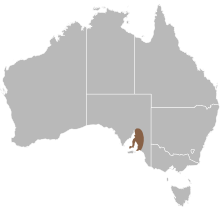Delma molleri
Delma molleri (commonly known as Gulfs delma and Adelaide Delma) is a small [the snout-vent length of the largest specimen measured 111 mm (4.4 in)], limbless lizard found in southern South Australia around the Adelaide Hills,[2][3] and pretty common in Adelaide suburbs.[4] Delma molleri has been recorded from a variety of habitats ranging from grassland to woodland beneath rocks, timber, and rubbish.[5][6][7][3][8][9] The species is oviparous.[2]
| Delma molleri | |
|---|---|
| Scientific classification | |
| Kingdom: | Animalia |
| Phylum: | Chordata |
| Class: | Reptilia |
| Order: | Squamata |
| Family: | Pygopodidae |
| Genus: | Delma |
| Species: | D. molleri |
| Binomial name | |
| Delma molleri Lütken, 1863 | |
 | |
| Range of Delma molleri in Australia. | |
The nucleotide (DNA/RNA) and protein sequences of D. molleri have been sourced through the European Nucleotide Archive (ENA) and Universal Protein Resource (UniProt) databases. The identification of the species as an Australian-dwelling organism has been achieved by accessing the Australian Plant Census (APC) and the Australian Faunal Directory (AFD) through the Atlas of Living Australia.[10]
Etymology
The specific name, molleri, is in honor of Danish ship's captain Möller who brought the holotype from Australia.[11]
References
- Fenner A, McDonald P, Hutchinson M. Robertson P (2018). "Delma molleri ". The IUCN Red List of Threatened Species 2018: e.T102830838A102830869. https://doi.org/10.2305/IUCN.UK.2018-1.RLTS.T102830838A102830869.en. Downloaded on 10 February 2019.
- Reptile Database.
- Shea 1991, pp. 71–90.
- Watharow 2011, p. 103.
- Cogger 2000, p. 290.
- Lütken 1863, pp. 292–311.
- Kluge 1976, pp. 1–72.
- Hoser 1989, p. 79.
- Museum Victoria.
- Research Data AU.
- Beolens et al. 2011, p. 181.
Sources
- Books
- Beolens, Bo; Watkins, Michael; Grayson, Michael (2011). The Eponym Dictionary of Reptiles. Baltimore: Johns Hopkins University Press. xiii + 296 pp. ISBN 978-1-4214-0135-5.
- Cogger, Harold George (2000). Reptiles and Amphibians of Australia (6th ed.). Sanibel Island: Ralph Curtis Publishing. p. 290. ISBN 978-0-88359-048-5. OCLC 45046861.CS1 maint: ref=harv (link)
- Hoser, Raymond Terrence (1989). Australian Reptiles and Frogs. Mosman, NSW: Pierson. p. 79. ISBN 978-0-947068-08-0. OCLC 712606765.CS1 maint: ref=harv (link)
- Lütken, Christian Frederik (1863). "20–22". Nogle nye krybdyr og padder [Some new reptiles and amphibians] (in Danish). Kbh. pp. 292–311. OCLC 473829131.CS1 maint: ref=harv (link)
- Watharow, Simon (2011). Living with Snakes and Other Reptiles. Collingwood, Victoria: CSIRO Publishing. p. 103. ISBN 978-0-643-09721-6. OCLC 752075766.CS1 maint: ref=harv (link)
- Journals and magazines
- Kluge, Arnold (1976). "Phylogenetic Relationships in the Lizard Family Pygopodidae: An Evaluation of Theory, Methods and Data". Miscellaneous Publications, Museum of Zoology, University of Michigan. University of Michigan (152): 1–72.CS1 maint: ref=harv (link)
- Shea, Glenn Michael (1991). "Revisionary Notes on the Genus Delma (Squamata: Pygopodidae) in South Australia and the Northern Territory". Records of the South Australian Museum. Australian Museum (25): 71–90.CS1 maint: ref=harv (link)
- Web
- "Specimen R 11125, Delma molleri, Squamata: Pygopodidae, Australia, Gulfs Delma". Museum Victoria.
- "Delma molleri ". The Reptile Database.
- "Nucleotide (DNA / RNA) and Protein sequences from the Australian dwelling species Delma molleri (Gulfs Delma)". Research Data Australia.
